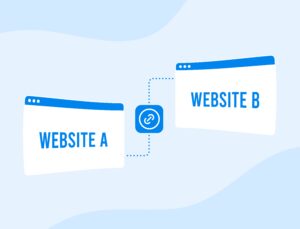
A full guide to external links

External links are a crucial part of any SEO strategy. Like their internal counterparts, they act as digital signposts, connecting and redirecting users across numerous websites – effectively ‘breadcrumbing’ the user until they find exactly what they’re after.
In this guide, our in-house experts will tell you everything you need to know about external links, from the basics to how you can implement them for better SEO activity.
A rich external link strategy is the backbone of an E-E-A-T-led user experience. It shows that your website understands a topic so deeply that you’re willing to improve the user’s knowledge too – even if it takes them away from your own domain.
Understanding External Links

But first – what is an external link?
Also known as an outbound link, an external link is a useful hyperlink that points users away from your website into an entirely different one. For example, you might be reading about magnetic drills – so it makes sense to include external links that could take you to a manufacturer’s website for context.
Boosting user experience
When you use links, you’re providing your users with additional, useful resources to help them learn more about a topic or explore new perspectives. This means that Google – and your audience – know to trust and rank your website as a reliable source.
Improving SEO with authority
External links also work the other way. Because search engines consider external links as a sign of credibility and authority, when another authoritative website links back to yours, it suggests your content is tried, tested, and trusted. Think of it like a vote of confidence in your content – which is viewed by Google as a sign of expertise, which can improve your website’s ranking on the SERP.
How to ensure links are high quality
When building a link strategy, focus on quality over quantity. To help you pick solid links, here are some key points to keep in mind when structuring your latest strategy:
- Relevance above all: Only link to trustworthy and relevant websites that offer genuine value to users and make sense with your content.
- Link to Authority Figures: Pointing to more established websites in your niche strengthens your website’s credibility by association – making it a useful ‘piggybacking’ method!
- Descriptive Anchor Text: Your anchor text should be clear and concise, describing the content the link leads to – preferably with relevant keywords that offer context for engines and users alike.
When choosing your links, you can begin to check whether they’ll meet your expectations. Make sure to ask yourself the following questions during your checks.
Best practices
- Credibility: As well as relevant, make sure to check if your linked website is a reliable source. That means scanning for established websites with a good reputation in your industry, with clear authorship, good design and accurate information.
- Content Quality: Skim through the linked webpage. Does it offer high-quality, well-researched content? If not – give it a skip.
- Broken Links: It sounds simple, but always make sure that your external link leads to an active webpage.
Tools you could use
We know that checking every external link can feel tedious. Luckily. There are a number of online analysis tools that can cut the time spent on checks in half, whether you need to look at the quality of links or the destinations themselves.
Backlink Analysis Tools: Ahrefs or Moz allows you to analyse the backlinks of a website, looking at a website’s domain authority and overall SEO strength.
Website Checker Tools: Tools like Sitechecker or Broken Link Checker can scan your chosen website and spot any broken external links.
Web Reputation Tools: Google Safe Browsing or Norton Safe Web can help you spot issues like malware or further web quality issues.
Creating a rich link tapestry
While SEO is important, user experience should always come first. That means avoiding ‘link stuffing’ and focusing on link opportunities that enhance your content and provide a seamless user journey that actually makes sense.
You can build trust with search engines and users by prioritising relevant, credible, and well-functioning links, with high-quality external links creating a more informative and navigable online landscape for your audience.
If you’d like some help implementing external links – or would like a bespoke SEO strategy created for your unique business – our experts can help.
